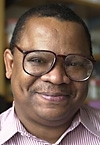CAMBRIDGE, Mass.--In a finding that could lead to a way to identify elusive adult stem cells, an MIT researcher reports in the Dec. 1 issue of Cancer Research that he has created cells that divide the way adult stem cells do--by hanging onto their original DNA and passing copies on to the next generation.
James L. Sherley, assistant professor of biological engineering and principal investigator in the Biotechnology Process Engineering Center at MIT, hopes his work will lead to a marker for therapeutically useful adult stem cells and help researchers better understand how we age and how cancer cells work.
Unlike embryonic stem cells, which exist only during early embryonic development, adult stem cells are the only cells in our bodies that create new tissues throughout our lifetimes. They may lead to promising new disease therapies such as organ and tissue replacement.
According to a longstanding theory in cancer biology, adult stem cells avoid mutations that may arise from DNA replication errors through a unique pattern of chromosome segregation.
When adult stems cells divide, the theory goes, instead of randomly passing along half their genetic material like other cells, adult stem cells keep their original DNA--so-called immortal DNA strands--and pass along only the copies.
According to a 1975 study by researcher John Cairns, this would help explain why cancer rates in humans and other long-lived mammals are not as high as they might be. If adult stem cells did not have a mechanism to protect their DNA, it would be rife with replication errors accumulating over a lifetime--more than our built-in repair mechanisms could handle.
NEEDLE IN A HAYSTACK
Adult stem cells produce new skin, intestinal lining, red blood cells and even brain cells. They have huge potential for tissue regeneration. Adult stem cells found in bone marrow, for instance, can be channeled to become fat cells, cartilage-forming cells or bone-forming cells.
Research on embryonic stem cells is limited in the United States. Adult stem cells are not controversial, but they are very rare and difficult to isolate because they look just like any other cells. Researchers who try to isolate them say it is easier to find a needle in a haystack.
CANCER-LIKE CELLS
When adult stem cells divide, one of the two resulting cells becomes a functioning tissue cell, and the other, which keeps the original copy of the DNA, stays a stem cell forever. While some researchers were confident that this process existed, "it wasn't clear that this mechanism could be demonstrated," Sherley said.
The usual way to mark DNA is to let it incorporate modified building blocks when it is being made. Newly made strands of DNA containing the modified building blocks can then be followed over time as they move into successive generations of cells. You can't do this with immortal DNA in adults because it is already made.
By manipulating a gene that is implicated in many human cancers, Sherley has created a line of cultured cells that do exactly what Cairns proposed. Sherley manipulated the gene that expresses the p53 tumor suppressor protein to create an immortal cell line that divides just like adult stem cells under one culture condition and like cancer cells under different culture conditions.
Although Sherley's cells are not cancer cells, they are immortal like adult stem cells and cancer cells. When Sherley's p53-manipulated cells are growing like cancer cells, it is possible to mark their DNA before immortal DNA forms. Thereafter, the cells can be switched to grow like stem cells and the fate of the labeled immortal DNA strands can be studied.
"It's not clear whether p53 causes the mechanism or puts the cell in a state where this mechanism occurs," Sherley said. "But it proves that mammalian cells can do what Cairns proposed."
Sherley and his co-authors--MIT graduate students Joshua R. Merok, and Janice A. Lansita and former MIT postdoctoral associate James R. Tunstead--write that their results, in addition to shedding light on cancer and adult stem cells, "lead us to consider new ideas regarding the nature of aging mechanisms. Some changes that occur in tissues with advancing age are likely to reflect alterations in the number and function of adult stem cells...Alterations that accumulate in these stable immortal DNA strands over time may compromise adult stem cell function and viability, precipitating a decline in tissue function."
Sherley points out that we still don't know how cells accomplish the unique process of maintaining immortal DNA strands. The next step is to look at the proteins that help humans' 46 chromosomes divide. There must be a unique set of proteins, he figures, behind this unique mechanism.
The identity of these proteins could lead to a quick and easy way to identify adult stem cells.
This work is funded by Defense Advanced Research Projects Agency (DARPA).






